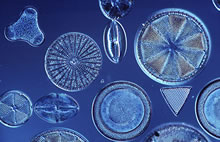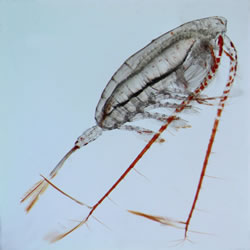“Plankton is probably the one place in the food web where the physics and the biology come closest together,” said Dr. Ted Cooney, professor emeritus at University of Alaska Fairbanks.
The marine community of the Sound is dominated by large phytoplankton called diatoms in the winter and early spring, and is taken over by a community of zooplankton called copepods in the summer.
Sea Changes
This seasonal change is thought to be created mainly by changes in light and heat throughout the year. In the winter when heat and light are low, diatoms and other phytoplankton spend their time in the nutrient-rich waters that float up from the bottom, sustained by the phosphates, nitrates and silicon that fell there the summer before. In the summer, a warm layer of water keeps the cooler nutrient-rich waters from rising to the top. Phytoplankton start to convert the energy from the sun, and this jump in productivity encourages copepods and other zooplankton to feed on the phytoplankton and grow in numbers.
These seasonal changes in microorganisms have been studied in the Sound for more than 30 years. However, even at this stage in the food chain scientists admit to having major holes in understanding the way life interacts with its surroundings. “We don’t know how primary productivity is reacting to changes in the ocean, but we’re pretty sure it does,”Cooney said.
The seasonal collections that have been done for so many years have taught scientists a lot, but still leave something to be desired. According to Cooney, science lacks information that would lead to an understanding of how these communities of microorganisms change on a daily, yearly or even decadal basis.
Modeling Nutrients and Plankton
Modeling nutrients and plankton has the potential to advance our understanding of how marine ecosystems respond to climate variability, and these physical and ecological predictions can be used to make better management decisions about living marine resources.
The long-term goals are to establish coupled circulation-ecosystem models that can produce nowcasts and forecasts of nutrients, plankton and marine habitat for fisheries in the Sound Gulf of Alaska.
Collecting Data During the Field Experiment
A small biological sampling program was designed to provide some observations to test the nutrient-phytoplankton-zooplankton (NPZ) model funded by OSRI. This was done by comparing model predictions to in situ observations, using profiling instruments and a small number of samples.
- Profiling instruments added to the CTD measured oxygen concentrations, nitrate concentrations and in situ chlorophyll fluorescence.
- Water samples were collected for nutrient analysis (nitrate, phosphate and silicate), extracted chlorophyll, and CHN analysis.
- Net samples were taken to measure mesozooplankton concentrations.
- Dissolved oxygen concentration was measured with a SeaBird Electronics SBE43 oxygen sensor, and nitrate concentrations will be measured with a Satlantic SUNA (Submersible Underwater Nitrate Analyzer).
- Chlorophyll fluorescence was measured using a WETLabs FLNTU and compared to extracted chlorophyll samples.
Sampling for nutrients and chlorophyll were collected during thermosalinograph cruises at the end of May and combined with samples collected during the field experiment. Samples were collected six discrete depths (surface, 5, 10, 15, 25 and 50 m) with a Niskin bottle.
Why Do We Care?
We need data on nutrients and plankton in order to be able predict plankton movements. To detect plankton, fluorometers were deployed on oceanographic moorings. This real-time data collection could provide a clearer picture of the movements of phytoplankton. In addition, acoustic surveys were used to track the movement of zooplankton as they traveled up and down in the water column or through the Sound.
These data help scientists infer how much biomass moves between the Gulf of Alaska and the Sound through Hinchinbook Entrance and Montague Strait, and how that transfer changes as the years and decades pass. Scientists then can better detect regime shifts, patterns in dominance, or geographic moves that may follow cycles. Once scientists know how the ocean affects movement and changes in populations of microorganisms, they can determine how the microorganisms cause changes in large animal populations in the food chain.



